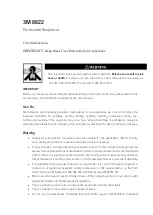
- 10 -
S-2018
REV. D
NIOSH APPROVAL
For a listing of the components in the ILC Dover respirator systems (ILC Dover
SENTINEL XL™ PAPR
CBRN)
that are NIOSH approved, refer to the NIOSH-approved label insert.
NIOSH CAUTIONS AND LIMITATIONS
A. Not for use in atmospheres containing less than 19.5 percent oxygen.
B. Not for use in atmospheres immediately dangerous to life or health.
C. Do not exceed maximum use concentrations established by regulatory standards.
F. Do not use this respirator if airflow is less than four cfm (115 lpm) for tight-fitting facepieces or six cfm
(170 lpm) for hoods and/or helmets
H. Follow established cartridge and canister change schedules or observe ESLI to ensure that cartridges and
canisters are replaced before breakthrough occurs.
I. Contains electrical parts that may cause an ignition in flammable or explosive atmospheres.
J. Failure to properly use and maintain this product could result in death or serious injury.
L. Follow the manufacturer's instructions for changing cartridges and/or filters.
M. All approved respirators shall be selected, fitted, used, and maintained in accordance with MSHA, OSHA,
and other applicable regulations.
N. Never substitute, modify, add, or omit parts. Use only exact replacement parts in the configuration as
specified by the manufacturer.
O. Refer to users instructions. And/or maintenance manuals for information on use and maintenance of these
respirators.
R. Some CBRN agents may not present immediate effects from exposure, but can result in delayed
impairment, illness, or death.
S. Special or critical User's Instructions and/or specific use limitations apply. Refer to User's Instructions
before donning.
Y. The respirator provides respiratory protection against inhalation of radiological and nuclear dust particles.
Procedures for monitoring radiation exposure and full radiation protection must be followed
GG. Direct contact with CBRN agents requires proper handling of the respirator after use. Correct disposal
procedures must be followed.
QQ. Use in conjunction with personal protective ensembles that provide appropriate levels of protection against
dermal hazard. Failure to do so may result in personal injury even when the respirator is properly fitted,
used, and maintained.
UU. The respirator should not be used beyond eight (8) hours after initial exposure to chemical warfare agents
to avoid possibility of agent permeation. If liquid exposure is encountered, the respirator should not be
used for more than two (2) hours.
VV. PAPRS with TC-23C approvals may NOT be used for escape from IDLH atmospheres.
Summary of Contents for S-5000 Series
Page 40: ... 39 S 2018 REV D ...









































